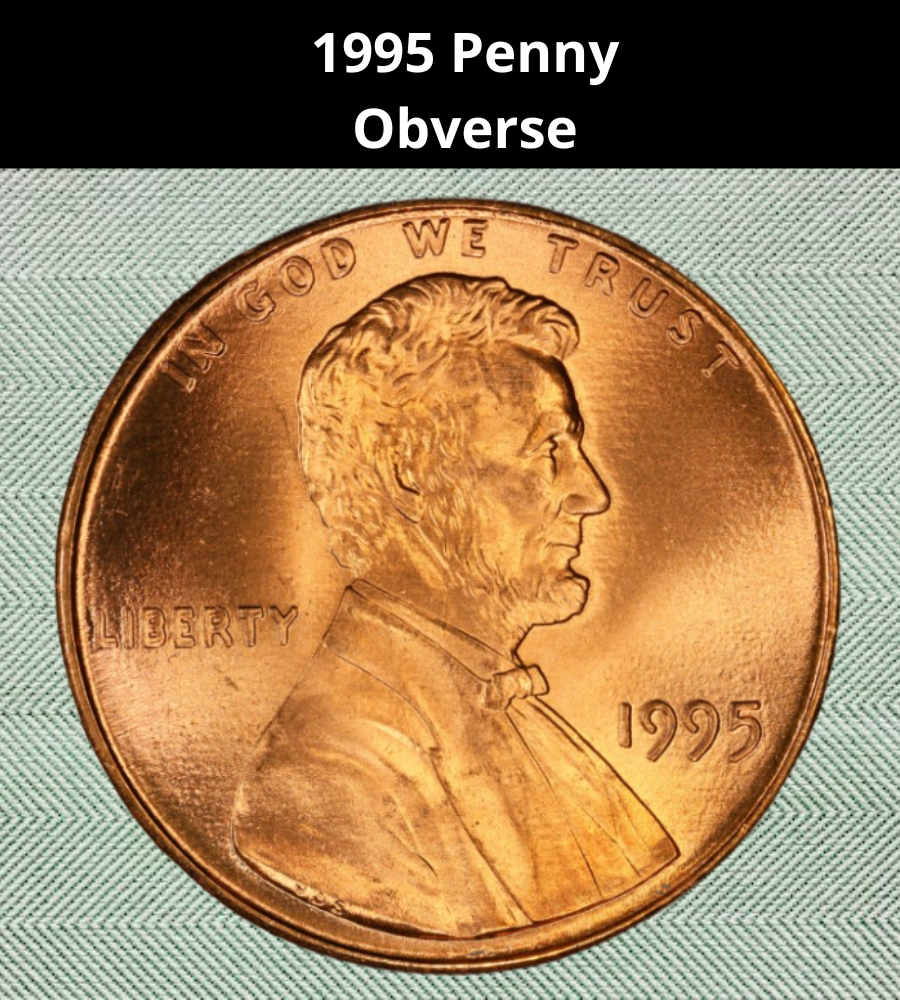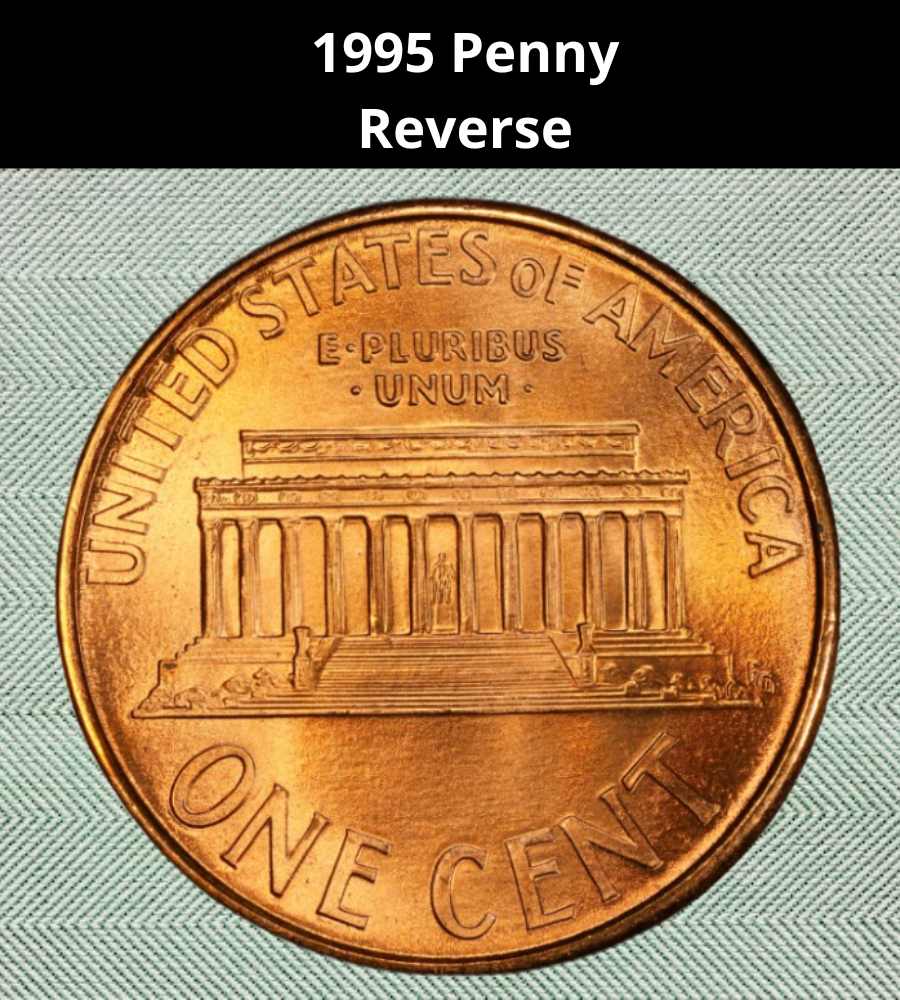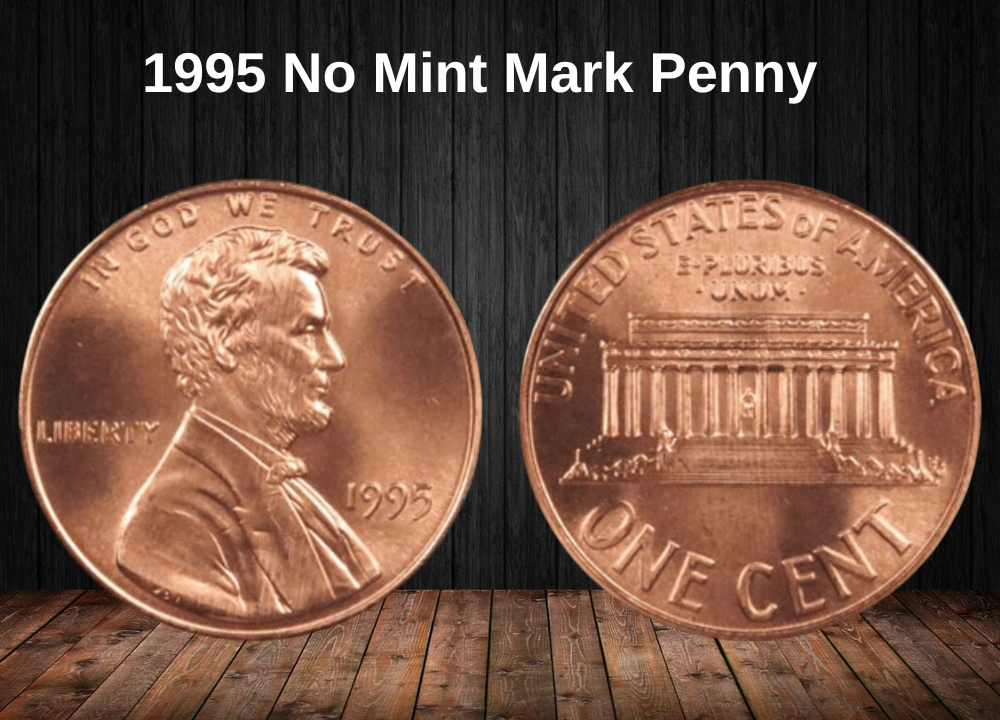The 1995 penny is a relatively modern coin, and as the smallest denomination in U.S. currency, most would assume it holds little value. However, certain special examples—especially those with high grades or mint errors—can be highly collectible and even valuable.
In this guide, we’ll explore:
- The value of the 1995 penny by type and grade
- Its design and historical background
- Mint errors that can increase its price
Let’s dive into the details.
1995 Penny Value Chart
Values listed are for coins with a red (RD) color designation.
| Mint Mark | MS60 | MS63 | MS65 | MS68 |
|---|---|---|---|---|
| 1995 (P) No Mint Mark | – | $6 | $10 | $115 |
| 1995-D | – | $6 | $10 | $135 |
| Mint Mark | PR60 | PR65 | PR68 | PR70 |
|---|---|---|---|---|
| 1995-S Proof | $1 | $4 | $7 | $32 |
History of the 1995 Penny

The 1995 penny belongs to the long-running Lincoln cent series, named after the iconic image of President Abraham Lincoln featured on the obverse.
A Century of Lincoln
The first Lincoln pennies were minted in 1909, commemorating the 100th anniversary of Lincoln’s birth. It was a historic moment—this was the first time a real person, rather than a symbolic figure, appeared on a U.S. coin. Before that, placing a person’s portrait on coinage was seen as undemocratic and too reminiscent of monarchies. But by 1909, public sentiment had shifted in favor of honoring one of America’s most revered presidents.
Since then, the Lincoln cent has been continuously produced, making Lincoln’s image the longest-running portrait in U.S. coin history.
Changing Reverse Designs
While the obverse has remained largely unchanged, the reverse has seen multiple redesigns:
- 1909 to 1958: Featured two ears of wheat, known as the “Wheat Penny.”
- 1959 to 2008: Showed the Lincoln Memorial, marking 150 years since Lincoln’s birth. This is the design on the 1995 penny.
- 2009: Featured four commemorative reverses for the bicentennial, each depicting a different stage in Lincoln’s life.
- 2010 to present: Displays the Union Shield, symbolizing Lincoln’s preservation of the United States.
Metal Composition
For decades, Lincoln pennies were made of 95% copper (bronze). But rising copper prices made production costly. In 1982, the U.S. Mint began transitioning to a zinc core with copper plating. By 1991, this composition became standard.
The change isn’t just visual—it’s also audible. Drop a post-1991 penny, like the 1995 cent, on a wooden surface and you’ll hear a dull, plasticky sound. A pre-1982 bronze penny, on the other hand, gives off a distinctive metallic “ping.”
Features of the 1995 Penny
The Obverse of the 1995 Penny

The obverse—or “heads” side—of the 1995 penny features a familiar image: the portrait of Abraham Lincoln, created by sculptor Victor David Brenner.
The Artist Behind the Icon
Victor David Brenner was born in what was then part of the Russian Empire, now modern-day Lithuania. Coming from a family of metalworkers, he brought his skills to the United States in 1890, where he soon made a name for himself as a medalist and sculptor.
His most famous work is arguably the Lincoln portrait seen on the penny. President Theodore Roosevelt personally sat for Brenner while he worked on a medal for the Panama Canal Commission, and it’s believed Roosevelt was so impressed that he pushed for Brenner’s selection as the coin’s designer.
Brenner envisioned Lincoln as if he were reading to a child—a moment of tenderness that, in his view, captured Lincoln at his most human and animated. That warmth and gentleness remain evident in the design over a century later.
Controversy Over the Initials
When the Lincoln cent was first issued in 1909, it included Brenner’s initials (V.D.B.) on the reverse. However, critics quickly complained that the initials were too prominent—calling it self-promotion or even advertising. Under pressure, the U.S. Mint removed them entirely, much to Brenner’s frustration.
Thankfully, the initials were quietly restored in 1918, this time on the obverse. On the 1995 penny, you can find “VDB” discreetly inscribed at the base of Lincoln’s shoulder, just above the rim.
Other Obverse Details
- “IN GOD WE TRUST” arcs across the top of the coin.
- The word “LIBERTY” appears to the left of Lincoln’s profile.
- The year “1995” is placed to the right.
- If the coin was minted in Denver or San Francisco, you’ll see the mint mark (D or S) just below the date. Pennies with no mint mark were struck at the Philadelphia Mint.
The Reverse of the 1995 Penny

The reverse side of the 1995 penny features a detailed engraving of the Lincoln Memorial, the iconic structure located in Washington, D.C. This design was created by Frank Gasparro, who served as the Chief Engraver of the U.S. Mint.
Spotting the Designer’s Mark
Gasparro’s artistic signature—his monogram “FG”—can be seen just to the right of the memorial, nestled beside the lower steps of the building. It’s a subtle detail that often goes unnoticed but is a hallmark of his work on U.S. coinage.
Layout and Inscriptions
The reverse follows a clean and symmetrical layout:
- At the very top, curving along the upper rim, is the inscription “UNITED STATES OF AMERICA.”
- Directly beneath it, in smaller letters, is the Latin phrase “E PLURIBUS UNUM,” which translates to “Out of many, one.” This historic motto refers to the union of individual states forming the United States.
- The denomination, written as “ONE CENT,” is displayed in bold, large font along the lower rim of the coin. Its size and placement ensure it’s easily recognizable.
An Architectural Tribute
Gasparro’s depiction of the Lincoln Memorial is more than decorative—it also holds a hidden detail. If you look closely, you can see a tiny seated statue of Lincoln between the columns of the building, echoing the real-life memorial’s interior sculpture by Daniel Chester French.
Other Features of the 1995 Penny
The 1995 Lincoln penny was produced in two primary formats: business strikes and proof coins. Each type was minted at a different facility and carries unique characteristics.
Mint Locations and Marks
- Philadelphia Mint: These coins were struck for general circulation and do not have a mint mark.
- Denver Mint: Business strike coins from Denver are identified by a small “D” on the obverse, just below the date.
- San Francisco Mint: All proof pennies were minted here and carry an “S” mint mark on the obverse. These coins were made specifically for collectors and are known for their mirror-like fields and frosted devices.
Color Designations: Red, Brown, and Red-Brown
Due to their copper-plated zinc composition, 1995 pennies display a range of tones, from bright red to rich brown. Over time, exposure to air and handling causes oxidation, gradually shifting the coin’s color.
Professional grading services like PCGS and NGC assign a color grade based on how much of the coin retains its original red luster:
- Red (RD): At least 95% of the coin’s surface retains its original mint red tone. These are typically the most valuable.
- Red-Brown (RB): The coin exhibits a mix of red and brown coloring, typically 5% to 95% red.
- Brown (BN): The coin is mostly or entirely brown, showing the most oxidation or circulation wear.
Collectors usually prioritize red (RD) examples in high grades, especially for modern coins like the 1995 penny.
1995 Penny Grading Guide
Understanding coin grading is essential to determine the true value of your 1995 penny. Coins are graded on a numerical scale from 1 to 70, where higher numbers indicate better condition and fewer signs of wear.
Here’s a simplified breakdown of common grades:
| Grade Number | Grade Description |
|---|---|
| 1 | Basal State-1 (Poor) |
| 2 | Fair |
| 3 | Very Fair |
| 4 – 6 | Good (G) |
| 7 – 10 | Very Good (VG) |
| 12 – 15 | Fine (F) |
| 20 – 30 | Very Fine (VF) |
| 40 | Extremely Fine (EF/XF) |
| 50 | About Uncirculated (AU) |
| 60 | Mint State (MS 60 – entry level) |
| 65 | Mint State (MS 65 – gem) |
| 70 | Mint State (MS 70 – perfect) |
Tip: The most valuable 1995 pennies are in Mint State (MS 60 and above), especially if they still have full red color (RD). Proof coins use a similar scale but begin with “PR” or “PF” instead of “MS”.
1995 Penny Value Guides
1995 No Mint Mark Penny Value

In 1995, the Philadelphia Mint struck approximately 6.4 billion pennies. While many have been lost, corroded, or worn beyond recognition, the survival estimate by PCGS suggests that over 2 billion coins still exist in all grades.
Because of this massive supply, circulated 1995 pennies (those graded below MS60) generally hold no value above face—they’re worth just one cent.
Uncirculated (Red) 1995 Pennies
Red coins (designated RD) are the most desirable, but even these are fairly common in lower uncirculated grades:
| Grade | Value (Approx.) |
|---|---|
| MS60 – MS64 | $1 – $6 |
| MS65 (Gem) | $10 |
| MS66+ | $16 |
| MS67 | $60 |
| MS68 | $125 |
| MS69 (Top Pop) | $7,850 (only 2 known) |
Top Tip: If you find a coin that appears flawless, it may be worth sending to a professional grading service like PCGS or NGC. Coins in MS67 or higher can fetch a significant premium.
1995 D Penny Value

The Denver Mint struck over 7 billion Lincoln pennies in 1995—surpassing even the Philadelphia Mint. Despite decades of circulation, around 2 billion coins are estimated to survive today in all grades.
As a result, circulated 1995-D pennies (grades below MS60) typically have no added value, remaining at face value.
Uncirculated (Red) 1995-D Pennies
While brown or red-brown coins are common and rarely exceed $1 in value, fully red (RD) uncirculated coins can command higher prices, especially at top grades:
| Grade | Value (Approx.) |
|---|---|
| MS63 RD | $6 |
| MS65 RD (Gem) | $10 |
| MS68 RD | $135 |
| MS68+ RD | $900 |
| MS69 RD (Top Pop) | $4,150 (only 7 known) |
High-Grade Rarity: The jump in value from MS68 to MS69 is dramatic due to extreme scarcity. Only seven 1995-D pennies have been graded MS69 RD, making them highly collectible.
1995 S Proof Penny Value

In 1995, the San Francisco Mint struck nearly 2.8 million Lincoln proof pennies specifically for collectors. These coins were produced using polished planchets and special dies, resulting in coins with exceptional detail and finish.
All 1995-S proof pennies exhibit the deep cameo (DCAM) effect — a strong contrast between the mirrored fields and the frosted design elements. Despite their beauty, these coins remain affordable due to their high survival rate and excellent preservation.
1995-S Proof Penny Value by Grade
| Grade | Value (Approx.) |
|---|---|
| PR60 DCAM | $1 |
| PR65 DCAM | $4 |
| PR68+ DCAM | $8 |
| PR69 DCAM | $14 |
| PR70 DCAM (Perfect) | $32 (1,363+ known examples) |
Deep Cameo Standard: All 1995-S proofs are considered deep cameos due to their striking contrast and quality from the minting process.
Collector-Friendly: Even PR70 coins—the highest grade possible—remain affordable and accessible, making this a great entry-level collectible for new numismatists.
Rare 1995 Penny Errors List
1995 (P) No Mint Mark Penny, Double Die Obverse

Double die errors occur during the die-making process. To transfer every fine detail onto a die, the mint presses the hub multiple times. If the die shifts even slightly between strikes, it causes a doubling effect—duplicated lines or shadows in the design.
This defect is then transferred to every coin struck from the faulty die.
- When the error appears on the obverse (front) side, it’s called a Double Die Obverse (DDO).
- If on the reverse (back) side, it’s a Double Die Reverse (DDR).
About the 1995 Double Die Obverse:
- Some 1995 pennies show a clear DDO, most noticeably on the words “IN GOD”.
- This year is significant because it’s the last year the Philadelphia Mint produced coins with double die errors. Starting in 1996, they switched to a single hub technique which virtually eliminated multiple hub strikes and the resulting doubling errors.
Value of 1995 Double Die Obverse Pennies:
The value depends heavily on condition (grade) and color designation (red, brown, or red-brown):
| Condition & Color | Estimated Value |
|---|---|
| Brown AU50 | Around $2 |
| Brown MS67 | Up to $40 |
| Red & Brown MS60 | About $5 |
| Red & Brown MS68 | Around $100 |
| Red MS60 | Around $16 |
| Red MS69 (High Grade) | Up to $4,250 (premium collectors’ value) |
1995 (P) No Mint Mark Penny — Broadstruck Error
Coins are normally held firmly in place by a retaining collar during striking to keep their shape and size consistent. However, if the collar is improperly positioned or missing, the metal can flow outward beyond the normal rim of the coin.
This results in a broadstruck error—a coin with a noticeably wider diameter and a flattened, irregular edge.
A 1995 penny struck in Philadelphia (no mint mark) was found with this broadstruck error. Graded MS62 Red by the grading service ANACS, it was in solid uncirculated condition with full red color.
Because broadstruck errors are relatively common compared to rarer mint mistakes, the premium on its value wasn’t extreme.
At auction, this penny sold for approximately $25.
Where to sell your penny?
Now that you know the value of your penny, you might be wondering where to sell it. Don’t worry: here’s a guide to some of the best online platforms where you can easily sell your coins, along with their advantages and disadvantages.
Discover the best platforms for selling coins online (pros and cons).
1995 Penny FAQ
1. What is the composition of the 1995 penny?
The 1995 penny is made of a zinc core (97.5%) coated with 2.5% copper, a standard composition used for pennies minted after 1982 to reduce production costs.
2. Were there any notable errors or varieties for the 1995 penny?
Yes, several error types exist, including doubled die obverse, off-center strikes, and die cracks. These errors can be rare and valuable depending on their severity and condition.
3. What mint marks are found on 1995 pennies?
1995 pennies were minted primarily at Philadelphia (no mint mark) and Denver (with a “D” mint mark). Additionally, proof pennies were produced in San Francisco and bear an “S” mint mark.
4. How rare is the 1995 penny?
The 1995 penny is generally common, with large quantities produced. However, certain error coins and proof versions can be considered rare and more valuable.
5. What is the average market value of a 1995 penny?
Most circulated 1995 pennies are worth face value (1 cent). Uncirculated and proof coins may fetch a few cents to a few dollars. Error coins can command higher prices depending on the type and condition.
6. What design features are present on the 1995 penny?
The obverse features Abraham Lincoln’s portrait, while the reverse shows the Lincoln Memorial, consistent with the design used from 1959 to 2008.
7. Is collecting 1995 pennies a good investment?
While most 1995 pennies are common and not considered good investments, collectors often seek out error coins and high-grade proofs, which can have better investment potential.


















































